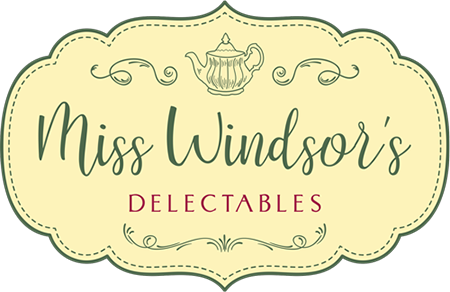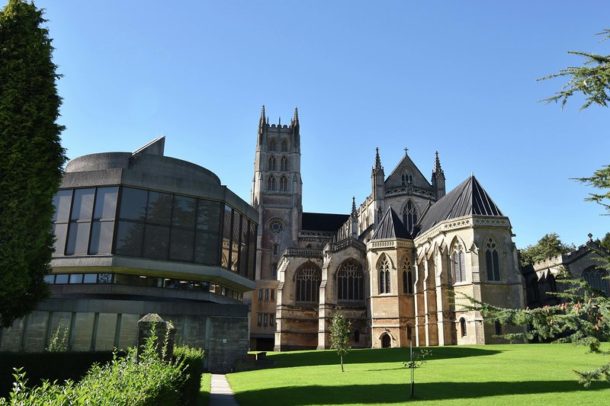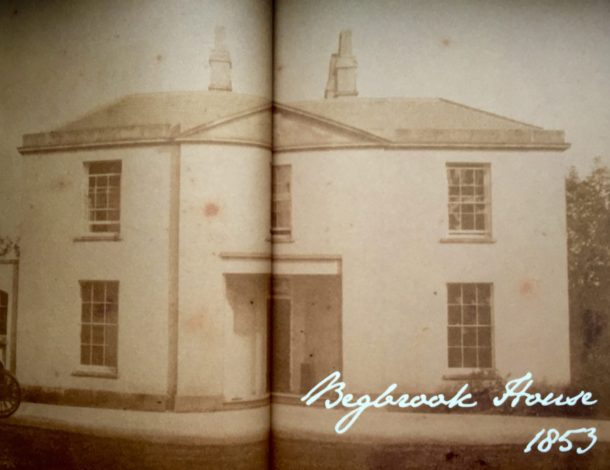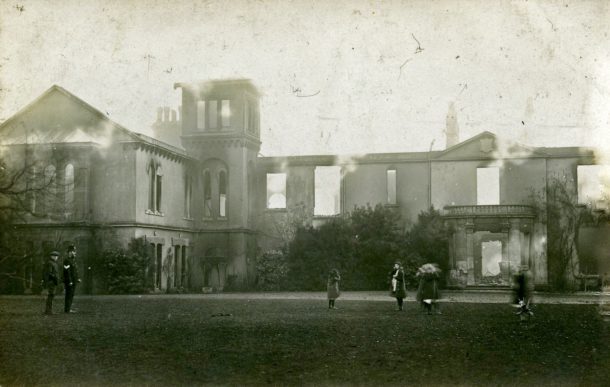|
Hello, darlings! One must say, it feels like an age since our last culinary rendezvous! But fear not, Miss Windsor has returned to flurry upon you exciting news about the discovery of a remarkable, handwritten cookbook from 1793 that originated from Begbrook House (Frenchay) Bristol, England , not too far from Miss Windsor's hometown of Backwell. But, according to the local and national press, this extraordinary ‘slice’ of Bristol’s culinary past – the Begbrook Kitchen Library, could possibly contain the oldest recipe for an English CHICKEN CURRY – Well, let’s see about that! This gem of a find was unearthed a few years ago by Monks, from deep within the archives of Downside Abbey in Stratton-on-the-Fosse, Radstock, Somerset, which is a ‘stone’s throw’ from the burial place of my great-grandmother Joan and her son David. Now darlings, for the sake of those fanatics, it’s not quite Downton Abbey, but it’s awfully close! One assumes you’re all ‘chomping at the bit’ to learn all about this incredible discovery by Monks! Well, to start with I consulted a plethora of avenues in search of a historical food connection with Bristol. Then ‘lo and behold’ I stumbled across Downside Abbey which is about 40 minutes from Bristol. Whom a few years previously had been granted money from the Lottery Heritage Fund to open up their archive’s and to restore the library. But would you ‘Adam and Eve it!’, this immensely important piece of culinary history was found by Monks on top of a ‘slave ship journal’, which is undoubtedly linked to Bristol’s sordid past with the transatlantic slave trade (what a disgrace). For many years it waited patiently, covered in dust, perched behind a box of paperwork concerning excavations at Glastonbury Abbey in Somerset – How fascinating! So, I consulted the Frenchay Village Museum, who informed me that Begbrook House was built during the late 1700’s by Thomas Graeme whose family owned Oldbury Court. Having thoroughly researched this subject, one presumes Thomas rented Begbrook House to Dr Robert Lovell who was born in Barbados and came to Bristol in 1792. Dr Lovell was elected Physician to the Royal Infirmary, which is known today as the Bristol Royal Infirmary. In 1793, one year following Dr Lovell’s arrival, this suitably employed piece of kitchenalia set sail from Bristol on its long and mysterious culinary journey! Evidently, Miss Windsor believes that the Begbrook Kitchen Library commenced this journey during the reign of the Lovell family. Whose housekeeper, or possibly the lady of the house forgathered many of the 142 recipes which were initially written using ‘goose quill’, then later with a ‘steel pen’ such as, Fricassee of Pigs Feet & Ears, Calves Head Turtle Fashion, Stew Knuckle of Veal, Stew Pigeons, Parsnip Pudding, Almond Faggots, Sally Luns, and of course CHICKEN CURRY! Over the years, Begbrook House experienced a change in ownership numerous times. Thus, Daniel Parsons a Catholic convert resided at Begbrook House along with his wife – the author Gertrude Parsons - from 1852 until they moved in 1855 to Stuart’s Lodge, Little Malvern in Worcestershire. According to Downside Abbey’s very own culinary enthusiast and local TV ‘personality’ – Father Christopher Calascione, “This was originally the hunting lodge for the Duke of Beaufort” – Well, I never! In fact, by sheer coincidence, Father Christopher spent ten years looking after the parish of Little Malvern, and Stuart’s Lodge just so happened to be located next to his church. During such time Father Christopher remarked, “This is when I started to cook for myself”. He then added, “The monastery (Downside Abbey) was pleased, as I managed to reduce the ‘house-keeping’ costs!” – good on you, Father Christopher. During the late 1800’s Daniel Parsons bequeathed the cookbook, along with other family papers and memorabilia to Downside Abbey, and as advised by Steven Parsons (Downside Abbey Outreach Officer), “He left Stuart’s Lodge to the Downside Monks of Little Malvern”. To Miss Windsor’s amazement, Daniel must have been quite attached to this leather bound culinary antiquity, which upon discovery aroused oodles of interest from far and beyond. The thing is, when dearest Daniel moved to Stuart’s Lodge, taking with him an immensely important piece of culinary history, he had no idea that he would play such a gallant role in preserving this ‘smitch’ of historical interest from one of Bristol’s most grand abodes. As sadly, today Begbrook House no longer stands, because it was completely gutted by fire in 1913 by Suffragettes (apparently!). Now, "What about that darn chicken curry!" I hear you utter! Well, I was absolutely fascinated that the Begbrook Kitchen Library could possibly contain the oldest recipe for an English chicken curry, which boasts the following ingredients of veal gravy, pounded rice and curry powder! Of course, I carried out some extensive research into such statement, which I found to be sensationalised by the local and national press. So, having delved deep into the history of chicken curry, I reveal that the most renowned and earliest published recipe for curry first appeared in an English cookery book which was written by Hannah Glasse in 1747 – The Art of Cookery made Plain & Easy. Darlings, but surprisingly the illustrious Hannah Glasse has a rival! Held by the Wellcome Library (London, England) is an anonymous manuscript from 1675, which contains an English recipe for a ‘vindaloo flavoured roast’ – anyone fancies a vindaloo flavoured roast cockerel? Darlings, please note that Miss Windsor could be hailed as the next local ‘hero’ for unveiling the truth about such a misleading statement. Therefore, the Begbrook Kitchen Library has been crowned by oneself as possibly containing Bristol’s very own, earliest, handwritten recipe for chicken curry. Indeed, a true Bristolian ‘heirloom’ and an outstanding piece of social history “Now, isn’t that just GERT LUSH,” Miss Windsor trumpets in her native dialect! You see, Hannah’s recipe from 1747 contains spice such as pepper and coriander seeds, therefore, she advised the adventurous home-cook or chef from yesteryear, how ‘To make a ‘Currey’ the India way’. Then in 1751 (4th edition), she introduced ginger and turmeric. Fast forward a few decades to the Bristolian version that requires a ready-made ‘ground’ substance called curry powder! Well darlings, it’s certainly common knowledge that several Bristolians’ could possibly be classed as ‘lackadaisical’ – in the realm of cookery, of course! Because, allegedly curry powder is an 18th century English invention (although, some folk may disagree), made purely for convenience! One of the earliest adverts on record is from the 1780’s, for the commercial sale of curry powder which could be purchased from 'Sorlie’s Perfumery Warehouse', No.23, Piccadilly, near Air Street, London. As quoted, ‘It is exceedingly pleasant and healthful’, and apparently aids digestion – Hmmm, not sure most stomachs would agree following an unfortunate episode of Delhi belly! The question is, “How did Bristol get its ‘mitts’ on curry powder during the late 1700’s?”. To solve this mystery I contacted Bristol Museum and conversed with Sue Giles the Senior Curator World Cultures who advised: “The East India Company held the monopoly of trade with India and the spice islands. But, grocers in Bristol would have bought Asian spices, including perhaps curry powder from wholesalers in London, as well as spices imported directly to Bristol from the Caribbean”. Thank you, Sue! Darlings, luckily Downside Abbey decided to share their treasured artefact with the outside community, and in 2017 published the Bristol Georgian Cookbook, which can be purchased from Amazon, or via their website: www.downside.co.uk I say, I must pop off now because one of my favourite tipple’s – Harvey’s Bristol Cream requires my undivided attention! Until our next culinary rendezvous, please do click on the image below and read my delightful interview with Father Christopher. Until next time,
0 Comments
Your comment will be posted after it is approved.
Leave a Reply. |
Archives
April 2019
Categories
All
|



















 RSS Feed
RSS Feed